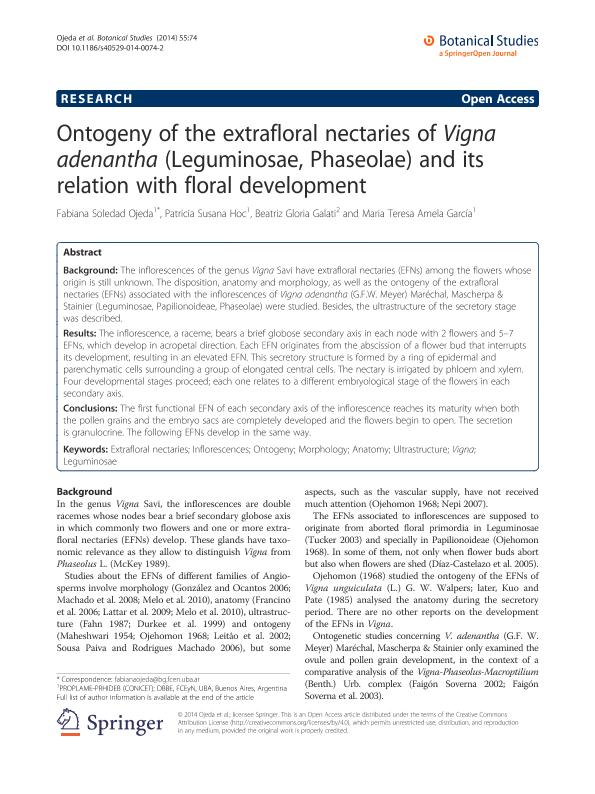Artículo
Ontogeny of the extrafloral nectaries of Vigna adenantha (Leguminosae, Phaseolae) and its relation with floral development
Fecha de publicación:
29/12/2014
Editorial:
Springer
Revista:
Botanical Studies
ISSN:
1999-3110
Idioma:
Inglés
Tipo de recurso:
Artículo publicado
Clasificación temática:
Resumen
Background: The inflorescences of the genus Vigna Savi have extrafloral nectaries (EFNs) among the flowers whose origin is still unknown. The disposition, anatomy and morphology, as well as the ontogeny of the extrafloral nectaries (EFNs) associated with the inflorescences of Vigna adenantha (G.F.W. Meyer) Maréchal, Mascherpa & Stainier (Leguminosae, Papilionoideae, Phaseolae) were studied. Besides, the ultrastructure of the secretory stage was described. Results: The inflorescence, a raceme, bears a brief globose secondary axis in each node with 2 flowers and 5–7 EFNs, which develop in acropetal direction. Each EFN originates from the abscission of a flower bud that interrupts its development, resulting in an elevated EFN. This secretory structure is formed by a ring of epidermal and parenchymatic cells surrounding a group of elongated central cells. The nectary is irrigated by phloem and xylem. Four developmental stages proceed; each one relates to a different embryological stage of the flowers in each secondary axis. Conclusions: The first functional EFN of each secondary axis of the inflorescence reaches its maturity when both the pollen grains and the embryo sacs are completely developed and the flowers begin to open. The secretion is granulocrine. The following EFNs develop in the same way. Keywords: Extrafloral nectaries Inflorescences Ontogeny Morphology Anatomy Ultrastructure Vigna Leguminosae
Palabras clave:
Extrafloral Nectaries
,
Inflorescences
,
Ontogeny
,
Morphology
Archivos asociados
Licencia
Identificadores
Colecciones
Articulos(INMIBO (EX - PROPLAME))
Articulos de INSTITUTO DE MICOLOGIA Y BOTANICA
Articulos de INSTITUTO DE MICOLOGIA Y BOTANICA
Citación
Ojeda, Fabiana Soledad; Hoc, Patricia Susana; Galati, Beatriz Gloria; Amela Garcia, Maria Teresa; Ontogeny of the extrafloral nectaries of Vigna adenantha (Leguminosae, Phaseolae) and its relation with floral development; Springer; Botanical Studies; 55; 74; 29-12-2014; 1-8
Compartir
Altmétricas




